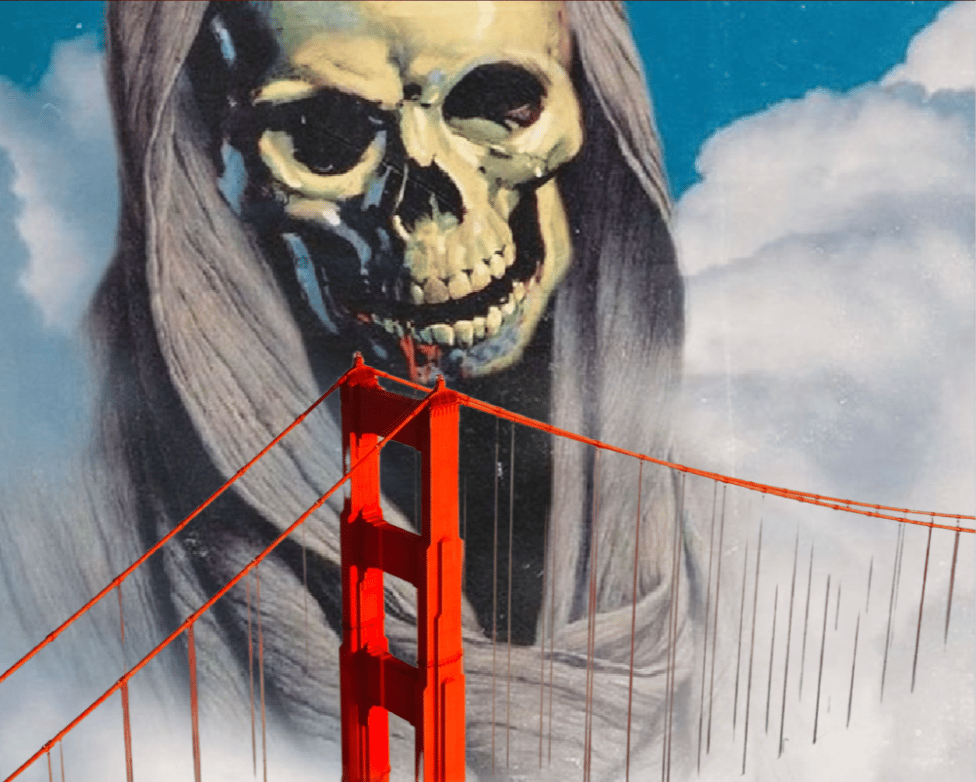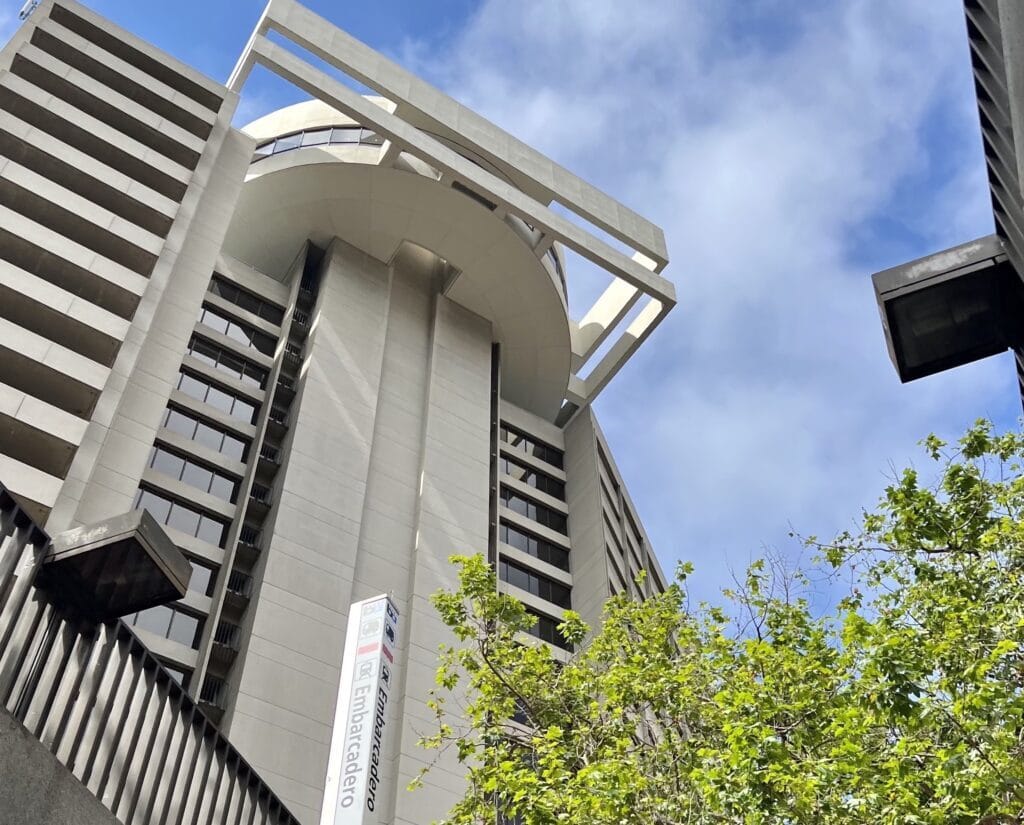
There’s indeed something looming over the Golden Gate. But it’s not what you might think. (Riley, Joe Donovan)
Long before conversations of doom loops, hope loops, or any other loops that crop up in casual conversation in the Bay Area, there was the matsutake mushroom. It’s a prized, resilient fungus that UC Santa Cruz anthropologist Anna Tsing describes as the ultimate example of rebirth in a post-capitalist world thanks to its ability to crop up no matter the wreckage. In her 2015 book The Mushroom at the End of the World, the researcher explores the United State’s obsession with scalability through the lens of the matsutake. She writes about America’s mega agriculture relying on “cloned planting stock, coerced labor, conquered and thus open land,” showing how “alienation, interchangeability, and expansion could lead to unprecedented profits.”
It might be useful to consider San Francisco as a resource for the purpose of this article. Like the matsutake mushroom, this is a city that, literally speaking, will remain in this part of what we now call California for probably the foreseeable future. Climate collapse, culture wars resulting in January 6 Capitol Attack-like destruction, and even open warfare from a foreign power aren’t likely to wipe away every remnant of the Palace of Fine Arts, Dolores Park, or Ocean Beach tomorrow.
San Francisco will go on whether we like it or not. Like a phantom lurking over the Golden Gate, however, the very real threats to San Francisco’s existence linger. What the city will look like in the future seems to be the real stick in everyone’s eye lately, and what that future is remains to be seen. But, even if a doom loop does turn San Francisco into your particular waking nightmare, there’s still hope in the city’s afterlife.
Crime, history, and recalls
Recalling openly-socialist Chesa Boudin, by and large through private funding, has not brought down crime in the city. According to the San Francisco Police Department’s own statistics dashboard, reported instances of rape, assault, burglary, and larceny theft are up in 2023 compared to 2022. In assault alone, the city has seen 1,758 cases this year. The argument that it’s all up to the district attorney never made sense, though one champion of that narrative was now-current DA Brooke Jenkins who, seemingly, is wobbling under her new responsibilities.
Local Journalism for Working stiffs
We write for the poets, busboys, and bartenders. We cover workers, not ‘tech’, not the shiny ‘forbes 100 bullshit’. We write about the business on your corner and the beer in your hand. Join the Bay's best newsletter.
Still, these statistics almost pale in comparison to the city’s policing debacles of 1979. San Francisco cops raised more than $100,000 in legal defenses of hometown hero Dan White, the man who murdered Harvey Milk and George Moscone in open daylight at City Hall. Further, he was exonerated under the now-infamous Twinkie defense. Locals took the city to task, resulting in the White Night riots. To make the year a banner one for local law enforcement, in March of that year off-duty cops terrorized lesbian bar Peg’s Place while getting fratty during a bachelor party.

San Francisco’s Embarcadero, site of much conversation and consternation. (Paolo Bicchieri)
The use in comparing just a few years of San Francisco history is to bring the image of the matsutake to mind once again. I admit, after reading Tsing’s book, that I see the comparison everywhere. Like mega agriculture, San Francisco politicians and developers have milked the city for all its worth since it became a city in 1850. Gold miners came for one thing and one thing only, as did tech workers in the advent of Silicon Valley in the 1970s, throughout the dot-com bubble of 2001, and the tax-incentivized tech takeover of San Francisco’s Market Street of 2011. In 2017 Forbes reported the San Jose-Sunnyvale-Santa Clara Metropolitan Statistical Area to house the most millionaires and the most billionaires in the United States per capita. Just like those Forty Niners in the 19th century up north, San Francisco serves those data miners down south — and likely always will.
Perception, downtown, and powerlessness
Unprecedented profits has always been the name of the game in San Francisco, the same American project applied to great swaths of farmland as it was to gold and processors. The issue for so many, then, seems not to be the crime downtown — as the mayor’s lieutenant is faring worse than the child of incarcerated political dissidents did. It doesn’t even seem to be the dizzying amount of fentanyl downtown or the allegedly dangerous unhoused population, as UC San Francisco found that community to be at a much higher likelihood of being harmed than harming anyone. It seems to be the perception of San Francisco that is at stake, the “vibes,” that the alleged doom loop will cast the Paris of the West into the sea like Atlantis before it.
But, like Atlantis, it’s just a myth. King babies like Elon Musk want to prevent San Francisco from “ending up like Detroit,” yet even for him and other haughty cranks like Y Combinator’s Gary Tan the issue is in preventing sweeps against the city’s homelessness, an obviously inhumane act. More importantly, these tyrants can’t seem to recognize their own fear lies in the mix once again: Where, in their minds, will these people go? Like conversations surrounding immigration or queer communities, there’s a denial afoot, a blank stare when asked what a sweep’s results would mean for San Francisco. Polished streets with all of the city’s poor cast into a boat headed into the sea? They might land at Angel Island, the irony of which would be lost on Musk and Tan as they applaud their good work.

On a recent afternoon, San Francisco wasn’t minding the negative attention. (Paolo Bicchieri)
What’s not a myth is the issues really facing San Francisco. Violence and drug overdoses are chief concerns, as they are anywhere, but amongst the heavy-hitting topics are housing markets so severe not even rich workers with a higher average income than anywhere in the country can’t buy a house — not that there’s any housing to go around — and aggressively corrupt city officials. Attack the issue of the day — transgender youth is another popular one for Mr. Musk — but it won’t control San Francisco’s future anymore than getting self-righteous on Twitter might. Delulu writers including Nellie Bowles joined the chorus when the opportunity arose, but even Bowles and her propagandizing wife Bari Weiss can’t wrap their minds around their powerlessness.
San Francisco doesn’t care what you think
For the ultra-rich and ultra-poor alike, San Francisco will continue. It’s an American city bound for extinction like the rest of the empire’s outposts. Tsing calls working and living in the post-capitalist landscape “salvage accumulation,” the logical end of primitive accumulation’s winner-take-all mentality. To beat this allegorical drum for the last time, San Francisco, our matsutake mushroom, will bloom in the rubble.
German economist E.F. Schumacher, counter-weight to villain economist Milton Friedman and his cabal the Chicago Boys, reminds readers in his classic work Small Is Beautiful that “unless virtually all educated people see themselves as servants of their country” it is impossible to adequately respond to each person in a capitalist society’s needs. I for one would love to see more middle- and upper-class San Franciscans pitching in for a finer city, the definition of that left to their own description.
San Francisco is, as writer Michelle Robertson put it, a city forever dying. The resource has been exhausted over and over again, scaled ad nauseam. Maybe the future of the city will be a hollowed-out downtown, completely run rampant by lawlessness and “squalor.” Maybe climate change-induced extreme weather events will flood the city in a Biblical apocalypse. But odds are the city survives whatever ruin you’ve decided it is bound for. Then, in the desecration, life will spring up out of the concrete and felled eucalyptus trees, flags billowing over Twin Peaks.
Update, September 12, 11:15 a.m.: An earlier version of this article failed to name Dan White correctly.
The post There’s A Future for San Francisco Whether You Like It or Not appeared first on Broke-Ass Stuart's Website.








